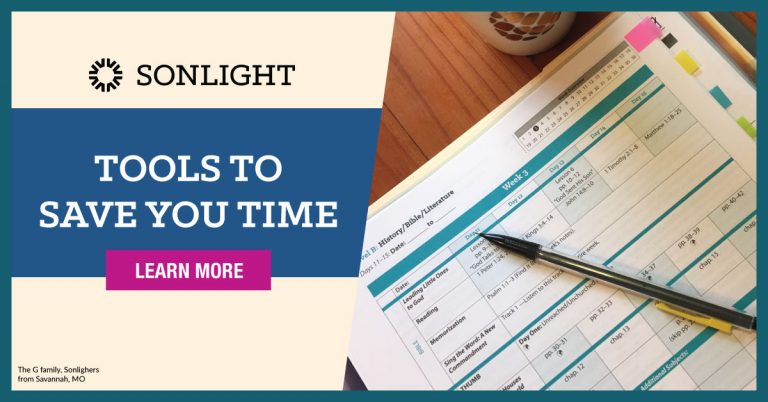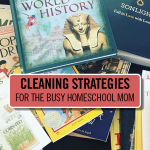
Having a large family can be chaotic. And messy.
One child might be cutting paper, a second playing with LEGO bricks, and a third sewing, while other children are in their rooms playing with toys. Dishes pile up, laundry hides under beds, and shelves overflow.
I find it hard to concentrate when the house is messy. I can tolerate a fair amount of chaos, but it reaches a limit where I start feeling stressed and frustrated. If I am feeling that, it stands to reason the clutter also affects my children, even if they are better at ignoring messes.
Messes also lower my motivation. Cluttered tables and counters reduces any incentive for performing science experiments and completing writing assignments. Laundry covering the sofa makes it harder to enjoy Read-Alouds. Being sick and knowing there’s a mess waiting makes it harder to feel better.
How Clean Workspaces Benefit Homeschooling
Homeschooling in a mess is harder than homeschooling in a clean area. When our rooms are cleaner, we find our days go more smoothly. Having a clean homeschool area helps our family:
- find supplies quickly and easily, reducing transition time between subjects
- focus with fewer distractions
- feel more peaceful, with fewer arguments over space or belongings
- fly through subjects faster because mood is improved
Keeping our working areas clean motivates us to work longer and harder than a messy space does.
1. Identify Problems Areas and Stress Zones
Certain messy areas affect some people more than others. I don’t mind if my children are playing on the floor, or have a cluttered corner, but anything at eye level bothers me. Messy shelves and dirty counters pull down my mood and increase my stress level. My husband, however, doesn’t mind cluttered counters, but hates messy floors. He can’t rest if the floor doesn’t feel clean enough to him, so he often sweeps and mops when he gets home before he can relax and enjoy being with his children.
By identifying areas which cause stress for each person, it’s easier to focus cleaning for the greatest impact. For example, when I’m about to start homeschooling , we clean counters and tables so I have a clean line of vision. When dad is on his way home, we pick up the floors.
Certain areas of the house also collect clutter. For example, we get used to putting all our mail in one spot, or placing laundry in baskets that need to be dealt with later.
Identifying those problem areas helps with strategies to make cleaning easier and faster. If I place a basket in the area that collects clutter, I can pick up the basket and carry it around with me while I hunt for homes for each object. If I place a recycle bin under the mail table, I can quickly sort the mail as soon as I get home.
2. Purge Unnecessary or Mess-prone Items
For our large family, one key to keeping a clean house is constantly purging:
- tossing broken toys
- discarding paper clutter
- storing outgrown clothing
Decluttering our house seems never-ending. But we are actually happier with fewer possessions. It’s easier to clean, easier to find toys they want to play with, and makes finding what we need simpler. It also gives us more places to put the things we want to keep.
With some objects, the memories they hold are more important than the actual item. In this case, take photographs of favorite homework assignments or rock collections and sort the pictures into online folders.
For purging, we use
- baskets (for items belonging elsewhere in the house)
- boxes (for things to be stored)
- garbage cans (for items to discard)
- white garbage bags (for donations)
- black garbage bags (for recycling)
- a caddy (for cleaning supplies)
I like to set aside 20 minutes for decluttering one spot of my home. I take everything out of the area, clean it, and put away only what belongs. Everything else gets sorted with my above list of containers.
3. Create a Space for Everything
One of the hardest things about keeping a house clean is dealing with things that don’t belong anywhere. By creating established storage places for items, it's easier to put them away.
- Box similar science kits and math manipulative together
- Create space on a closet shelf for rarely-used games and learning tools by hanging up linens instead of stacking them
- Set aside a little cupboard corner for homeschool supplies.
Having a set place for everything helps make cleaning less stressful for your children, too. They won’t feel a need to hide things that they can’t find homes for or ask you where each item goes.
4. Create Ongoing Cleaning Routines
One big cleaning job is usually necessary at least twice a day, but we can make those lighter by cleaning in between those times. Here are tips for ongoing cleaning:
Localized Cleaning: Choose one area that needs to be cleaned the most, and focus on that alone.
Basket/Box Cleaning: When cleaning an area quickly, place items that don’t belong in that area in a box or basket to be put away later. It’s easier to carry around a basket of supplies than put away each item one by one.
Cleaning Music: Finish cleaning before a set number of songs pass, or dance to music while you clean. You can play various types of educational music during this time.
Challenges: Race a timer or each other. Add challenges such as “I think I can clean all the toy cars before you can clean all the blocks.” Only items correctly put away count. This is a great activity for children still learning to count and sort to work on those skills.
5. Tackle Laundry Immediately
My oldest four children are in charge of washing and drying two loads of laundry each per week. I don't assign specific clothes, so they can do any two loads. I do anything left over, which is usually minimal.
When a load is complete, we bring it to a central place. Then, my oldest children put clothes on hangers (we hang everything possible, with long racks to hang the clothes, so little goes in drawers), and I fold any items requiring folding. The four youngest try to beat us by rushing to put each pile and set of hangers away as fast as possible. We can put away a full load of laundry in minutes, and it doesn’t sit in baskets. Since they only have to put away a dozen or two items each time, it makes it more fun and easier than sorting through piles of clothes.
Hopefully, some of these tips and techniques for cleaning our house can be adapted to help you keep your house a bit cleaner and better organized. With a large family, your house may never be completely clutter-free, but it can be less stressful and make your school and rest times feel better, too.
Sonlight helps you organize your homeschool day with detailed Instructor's Guides.








